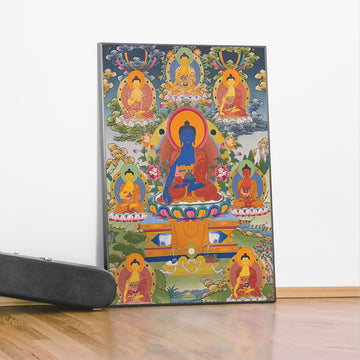The White Tara Thangka is a powerful and revered artwork within the Tibetan Buddhist tradition. Depicting the Bodhisattva Tara in her peaceful, white form, this intricate piece of art is believed to bring healing, protection, and spiritual growth to those who behold it.
But for those unfamiliar with Tibetan Buddhism and its iconography, the White Tara Thangka can be a bit of a mystery. In this blog post, we'll delve deeper into the significance and symbolism of this beautiful and meaningful artwork, so you can better understand its importance and purpose.
First, let's start with a little background on the Bodhisattva Tara. In Tibetan Buddhism, Tara is seen as a female deity who represents compassion and the attainment of enlightenment. She is often depicted in different colors, each representing a different aspect of her being and the qualities she embodies.
The White Tara, in particular, is associated with healing and long life. She is often depicted seated on a lotus throne, with a peaceful expression on her face and her right hand in the gesture of granting wishes. This posture is known as the "granting boons" mudra, and it symbolizes the boundless compassion and blessings that Tara offers to all beings.
But the White Tara Thangka is more than just a beautiful depiction of a deity. It is also a tool for meditation and spiritual growth. The intricate details and symbolism within the Thangka are meant to guide the viewer towards a deeper understanding of the Buddha's teachings and the path to enlightenment.
For example, the lotus throne on which White Tara is seated represents the pure and unshakeable nature of the mind, as well as the potential for enlightenment. The white color of her body represents purity and the attainment of spiritual perfection. And the seven eyes on her forehead and palms symbolize her all-seeing and all-knowing nature. These eyes represent the ability to see the suffering of all beings and the potential for enlightenment within them.
In Tibetan Buddhism, Thangkas are often used as a focus for meditation and visualization practices. By contemplating the symbolism and meaning within the White Tara Thangka, practitioners can cultivate the qualities of compassion, healing, and spiritual growth within themselves.
The White Tara Thangka is also filled with other symbols and imagery that hold deep significance in Tibetan Buddhism. For instance, the lotus flower that White Tara holds in her left hand represents the purity of the heart and the potential for enlightenment. The long life vase that she holds in her right hand represents the longevity and good fortune that she bestows upon her devotees.
In Tibetan Buddhism, the White Tara is often invoked for healing and protection, particularly during times of illness or danger. It is believed that by focusing on the White Tara Thangka and reciting her mantra, one can tap into the powerful energy of this compassionate deity and receive her blessings.
So the next time you come across a White Tara Thangka, take a moment to appreciate the beauty and meaning behind this powerful piece of art. Whether you are a seasoned practitioner or new to Tibetan Buddhism, the White Tara Thangka has much to teach and inspire. By understanding the symbolism and significance of this artwork, we can tap into the powerful energy of the Bodhisattva Tara and cultivate her qualities of compassion and spiritual growth within ourselves.





